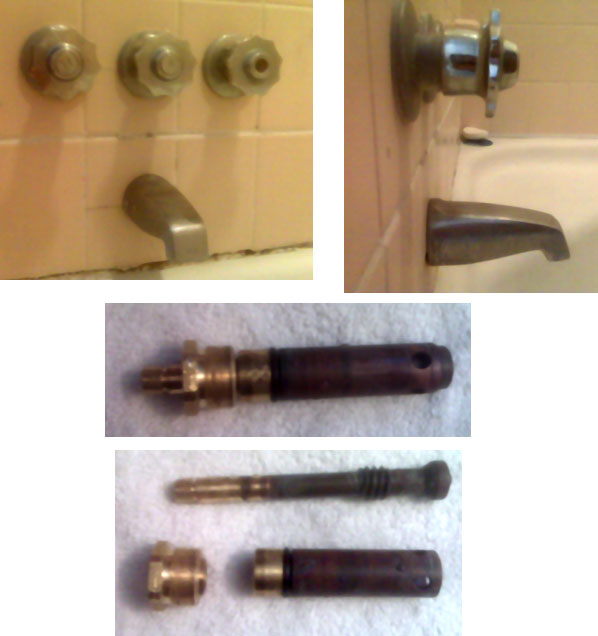labumm
New Member
I have an American Standard Diverter valve that is not working properly. It sends 100% of water to the 'tub filler mode' but in 'shower mode" still sends about half the water to the tub filler.
I have removed the valve stem and catridge. I replaced the washer (#0) at the end of the stem that contacts the seat at the bottom of the valve body. I also lubed the valve threads. The lube makes it turn more easily, but in 'shower mode' the bypass to the tub filler is still ~50%. The stem seals are fine--not even a drip. Visual inspection of the seat at the bottom of the valve body shows no roughness or corrosion. The valve turns only 180deg (half turn), as I assume it is supposed to do.
Here are some pictures:

I know the photos are not very good, my cell phone does not have a macro mode. For a better view, I think it is this part:
http://www.plumbingparts.org/parts/982852.html
If I understand the function of this valve, here is how it works.
*Water enters the valve body from the side, close to the bottom.
*Water to the tub filler leaves the side of the valve body further up the valve body.
*Water for the shower leaves at the bottom (end) of the valve body.
In 'tub filler mode' the valve stem is fully extended against the bottom of the valve body. This closes the path to the shower (washer and valve seat at bottom of stem). At the same time, full extention of the stem opens a channel between the bell of the valve stem and the catridge, allowing water to flow into the center of the catridge and out through the holes in the cartridge farther up.
In 'shower mode' the valve stem is fully retracted. This places the bell tight against the catridge, closing the path to the tub filler. At the same time, the path to the shower opens.
So what is going wrong? I suspect that water is bypassing around the outside of the catridge. It seems that there should be a better seal there. At the same time, I don't see how that could be practically implimented in this design. Trying to craft a seal runs the risk of getting the catridge stuck, or the seal jammed in the bottom. I realize that diverters don't seal like 3-way valves, but the performance should be much better.
Any ideas? This is where years of experience would come in handy.
Keep in mind that I do not know the maintaince history. But this is the original shower installed in 1966.
Thanks in advance for you time.
I have removed the valve stem and catridge. I replaced the washer (#0) at the end of the stem that contacts the seat at the bottom of the valve body. I also lubed the valve threads. The lube makes it turn more easily, but in 'shower mode' the bypass to the tub filler is still ~50%. The stem seals are fine--not even a drip. Visual inspection of the seat at the bottom of the valve body shows no roughness or corrosion. The valve turns only 180deg (half turn), as I assume it is supposed to do.
Here are some pictures:

I know the photos are not very good, my cell phone does not have a macro mode. For a better view, I think it is this part:
http://www.plumbingparts.org/parts/982852.html
If I understand the function of this valve, here is how it works.
*Water enters the valve body from the side, close to the bottom.
*Water to the tub filler leaves the side of the valve body further up the valve body.
*Water for the shower leaves at the bottom (end) of the valve body.
In 'tub filler mode' the valve stem is fully extended against the bottom of the valve body. This closes the path to the shower (washer and valve seat at bottom of stem). At the same time, full extention of the stem opens a channel between the bell of the valve stem and the catridge, allowing water to flow into the center of the catridge and out through the holes in the cartridge farther up.
In 'shower mode' the valve stem is fully retracted. This places the bell tight against the catridge, closing the path to the tub filler. At the same time, the path to the shower opens.
So what is going wrong? I suspect that water is bypassing around the outside of the catridge. It seems that there should be a better seal there. At the same time, I don't see how that could be practically implimented in this design. Trying to craft a seal runs the risk of getting the catridge stuck, or the seal jammed in the bottom. I realize that diverters don't seal like 3-way valves, but the performance should be much better.
Any ideas? This is where years of experience would come in handy.
Keep in mind that I do not know the maintaince history. But this is the original shower installed in 1966.
Thanks in advance for you time.
